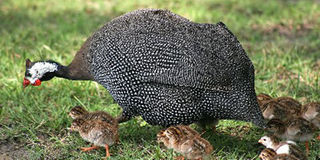Behold the guinea fowl, a bird with lean meat and great beauty

Guinea fowl and chicks.PHOTO|FILE|NATION
What you need to know:
- Guinea fowls prefer free-ranging (as they eat insects and grains) to regimentation
- Their preferred nesting location is in long grass or under a bush.
- Compared to chickens, guinea fowls are low-cost and low-maintenance and virtually disease-free
- Sh1,500- The amount of money in shillings one pays to Kenya Wildlife Service to rear guinea fowl.
Sometime in April 2013, I received a call from Okello, the worker on my farm in Busia.
“I have found 27 eggs in the bush near the mango tree,” Okello said excitedly.
“How do they look like?” I asked, equally thrilled.
“They are much smaller than those of chicken, and they have a very tough shell, with a sharp pointed end.”
I figured out these could be eggs from my guinea fowl (I had bought a male and a female from a farmer), because those from turkeys and geese are much bigger.
I was happy that after waiting for over a year, the bird had started laying eggs. But 27 is on the lower side, an average hen will lay about 100 eggs and will continue laying that number for up to five years.
Once again, I gave the 27 eggs to a broody hen, and ended up with 10 keets (young ones).
I first fell in love with guinea fowls when I visited the Arabuko-Sokoke Forest in Kilifi County and saw the crested guinea fowl with its black plumage and white spots and distinctive black crest on its head. Arabuko-Sokoke forest, which spans 420 square kilometres, is the largest and most intact coastal forest in East Africa, with 20 per cent of Kenya’s bird species, 30 per cent of butterfly species and at least 24 rare or endemic birds, mammals and butterfly species, according to Kenya Forest Service.
You need to see a guinea fowl majestically patrol the lawns scouring for ants, cockroaches, grasshoppers and grass with its keets in hot pursuit to appreciate this beautiful ornamental bird.
If you are looking for a bird with lean meat that is also rich in protein, then the guinea fowl should be your choice. Unlike turkeys that originated in the Americas, guinea fowls were exported to Europe by 15th century Portuguese explorers, and then arrived in North America with the early settlers.
There are seven species of guinea fowls, but the ‘helmeted pearl’ is by far the commonest, and certainly the ‘weirdest’ looking, with its oddly shaped helmet, white, featherless face, bright red wattles, and gray polka-dotted feathers.
I must warn you from the onset that guinea fowls prefer free-ranging (as they eat insects and grains) to regimentation. Although they always come back for the evening (I mean always), confining them during the day, is a problem.
But this comes with numerous challenges. Many a times I have had to spend days scouting around the bushes in the neighbourhood looking for their eggs that they lay after six to eight months.
Sometimes I am lucky, but other times I have found the eggs eaten by dogs and other predators. Their preferred nesting location is in long grass or under a bush.
My manicured grass lawn puts them off and that is why they prefer to spend their daytime in the bushy neighbourhood. I guess this free spirit characteristic of these birds is one reason the researchers at Kenya Agricultural and Livestock Research Organisation have not exploited them commercially to come up with a “Kari Improved Guinea Fowl”.
Managing fowl's movements
In a way, their ability to fly protects them from predators. But instead of allowing them to come and go as they please, one can cover the pen with a net to prevent them from flying away.
That aside, and you can take this to the bank, compared to chickens, guinea fowls are low-cost and low-maintenance and virtually disease-free. In fact, I have never seen them succumb to diseases. Of my two birds that died, one was killed by a dog, while the other was killed by a turkey.
I have never tried this, but experts advise that to prevent the birds from flying away, one should try a technique called pinioning.
This involves clipping off the last joint of one wing, at the thumb, when birds are less than a week old. It is inadvisable to pinion free-ranging guineas as this prevents them from flying away from predators.
Another thing I have heard from villagers in Busia, which I don’t believe, is that these birds can fly away in response to noise from their wild cousins and the solution is to plug their ears with wax.
KWS licencing
Despite their numerous benefits, many people don’t know that guinea fowls can be domesticated. I remember one time during Christmas, I had guests from Nairobi visiting, and, on seeing the birds, they were excited thinking wild birds had strayed into my compound.
Immediately, they started chasing after them with stones and sticks. Had I been far, they would have killed them for a sumptuous meal.
Another thing to remember is that although these birds are domesticated, according to the Wildlife Act, they are classified as “wild”.
That means you need a licence to rear them. The licensure process at the Kenya Wildlife Service on Langata Road, Nairobi, requires the following documents: a map to the farm, a picture of the nest and payment of Sh1,500 fee.
Guinea fowls fetch a good price, about Sh3,000 each, and are in great demand.
Obwogo is a poultry farmer, a medical doctor and a senior quality improvement adviser in health policy.




